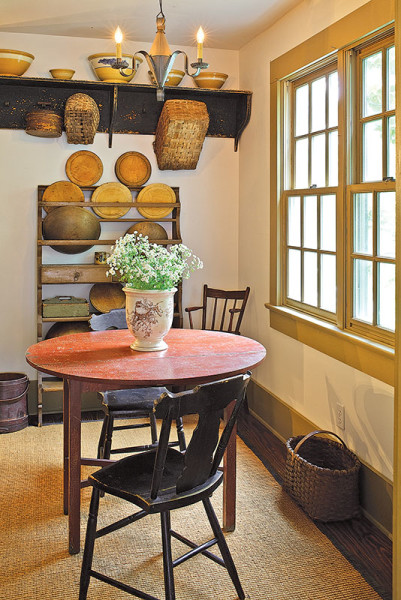
In an 1840 house, a drop-leaf tavern table in original red paint sits on a natural-fiber mat. (Photo: William Wright)
The house in the St. Lawrence Valley is preserved as time left it, and is now filled with local antiques. The interior is hard to describe. France ceded North American colonies to Britain in 1763, and the dominion of Canada was not formed until 1867. Yet this house, built in 1838, is not colonial, nor does it display urban style. What period is it?
Queen Victoria ascended the throne in 1837, but the styles we think of as Victorian usually fall between 1860 (or after the U.S. Civil War) and as late as 1910. What are we to make of the period 1830 to 1850? At the time, more than 90 percent of Americans lived in rural areas, but it was a time of growth and change in transportation and manufacture. Wealth continued to inform interior design and such amenities as lighting and plumbing. Here are some general guidelines for interiors and furnishings
in the period.
WALLS & TRIM Walls were not always whitewashed. Stairhalls were painted in quiet colors, drawing rooms might be more colorful. Rooms facing north or east were done in warm colors, while those facing south or west wore cooler greys, violets, blues, or greens. Woodwork—casings, the baseboard or mantel—might be marbleized. Hallway wall plaster was scored as it was applied in imitation of ashlar (cut and dressed stone blocks), or a similar effect might be achieved through wallpaper. Bedrooms had light-colored walls and were often papered.
FLOORS Matting, painted canvas floorcloths, and cheap woven coverings already were available in the 18th century. Hand-loomed ingrain and Brussels carpets were more widely available by the 19th century. Mostly, floors underneath were bare softwood boards, neither stained nor varnished. Cleaning involved scrubbing with sand and brushes, or bleaching with lye.
Painted floors were common. Tastemakers urged painting the exposed borders around the edges of large rugs. Paint-stenciled floors and floorcloths were other options. Matting was recommended for almost any room. Carpet matting was to be laid wall to wall; “mats” referred to smaller rugs. Both were available in many fibers, including sheepskin and thick woolens, as well as coconut fiber and flat-woven grasses from the Far East. Homemade rag rugs were common.
Plain and figured quarry tiles were in use during this period. By midcentury, plain or patterned English tiles were marketed in the U.S. as encaustic tiles. Downing suggested that patterned inlay tiles were more durable and thus more economical than carpets and floorcloths for high-traffic rooms.
WINDOWS Wood shutter-blinds and Venetian blinds were in use. The 1830s and ’40s predate the period of Victorian multi-layer treatments. In any case, expensive drapery in rich fabrics hung only in the windows of the wealthy, and usually urban, class. Rural householders used cotton (calico, dimity, chintz) and muslin. The inexpensive roller shade was quite popular. Window curtains might be very simple—just matched panels shirred on a rod or cord, or tacked to the window header. A short valance often covered the top of the curtains. The so-called Venetian curtain, akin to a Roman shade that may be drawn up, was recommended.







